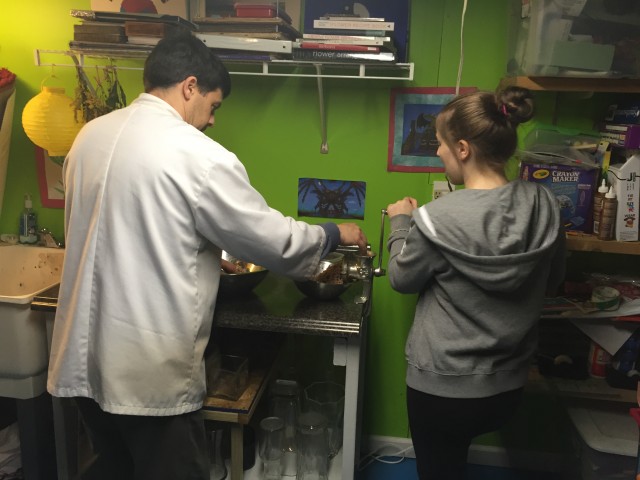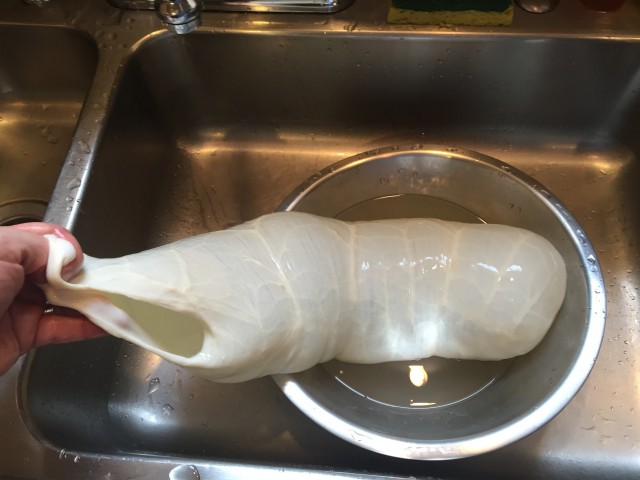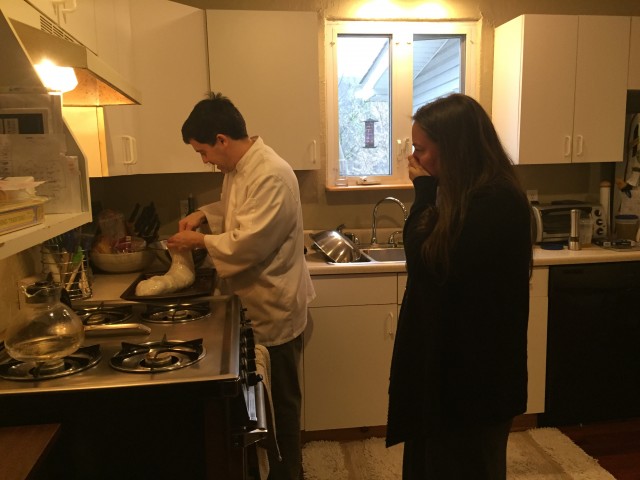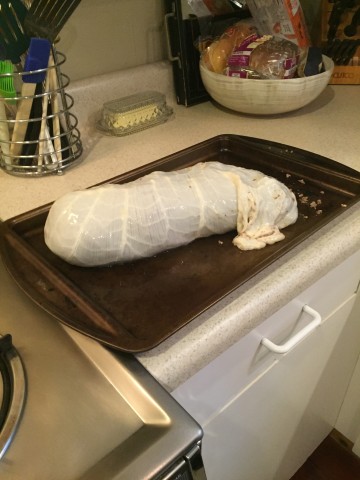Next comes the grinding of the meat, suet, and onions. This is a good part, especially since I make the kids do the labor of turning the grinder! In truth, they enjoy it and Samantha is always there to help operate the grinder whenever I make anything using it. I started making the haggis when Debbie and the kids were out for a while and Samantha specifically asked for me to wait to grind it. I also like using this device as it’s an old grinder, probably from the 40’s, given to us from Debbie’s great-aunt and still works just as well as it has for decades. And yes, that’s a chef coat. The kids gave it to me as a father’s-day present and I like it since it keep my shirts free of mess and grease splatter!
Next, everything gets mixed together in a big bowl with the oats, spices, and some stock.
Once everything is mixed, it’s stuffed into the ox bung (the casing), which first needs to be cleaned and soaked to soften it. This is where things get a little wild and truly unique for what would typically occur in any normal kitchen. Correction – anyone who has ever stuffed a chicken or turkey will easily relate to this step since it’s a common experience to wrap the skin of the bird around the bulging stuffing or toothpicks are used to hold the skin in place. On the other hand, no chicken is quite like this thing, which I admit resembles a monster-sized condom!
Even though most people have never heard of an ox bung/beef cap, with the rise of the internet and ease of finding most anything you could want, it’s a simple search to find these from sausage supply companies. Natural casings are simply shipped in plastic bags, coated with a bunch of salt. They’re noted for their strong smell, which is normal and expected. I’ve used hog casings for sausage before, but working with this was new to me. I liked the conversation I had with the guy on the phone when I ordered it from the sausage company in Wisconsin. “I’ve never used one of these before and was wondering if it’s going to be OK simply being shipped through the mail without any ice packs or anything?” His response was, “Oh yeah. It’ll be fine. You could leave this thing out in the sun in summer for days and it would still be OK.”
Yes, the smell was a little strong at first until after it was rinsed for a little while. Samantha was enjoying watching me go at it, while gaurding her nose from the odor. Here’s the casing, nice and pliable, ready to be stuffed.
I should also point out that this is only 1/2 of the entire beef cap. This was to keep the size of the haggis to a reasonable amount. I’ll explain later. Now to stuff the pudding (meat mix) into the casing.
This next image is of Debbie looking on with a gesture that is 80% childish disgust and 20% odor protection. I’m probably going to get in trouble for that comment. 🙂 One thing that has come across to me as this interest in traditional foods has grown, is that these foods are just that – things to eat. And the disgust everyone associates with organ meats or anything similar is, in my opinion, mostly from lack of exposure and the long-standing wealth of our country that gives us the opportunity to not bother with such things. Thats’ right, it’s the luxury we have that our ancestors in Scotland or where ever didn’t have. And if they didn’t eat what was on the plate they would go hungry. Every part of an animal was eaten or used because it would be at their own detriment if they didn’t. And don’t get me wrong, I like many of the things wealth brings, but I also like the grounding and practical outlook that comes from aspects of poverty.
OK, it looks like I’ve slipped into a rant again. Sorry. The stuffing is complete.
Go to the first page Continue to Part 4








